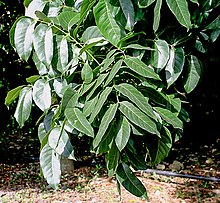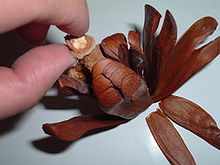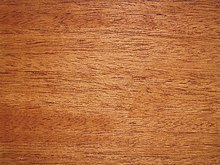American mahogany
| American mahogany | ||||||||||||
|---|---|---|---|---|---|---|---|---|---|---|---|---|

Young specimen of |
||||||||||||
| Systematics | ||||||||||||
|
||||||||||||
| Scientific name | ||||||||||||
| Swietenia macrophylla | ||||||||||||
| King |
American mahogany ( Swietenia macrophylla ), also known as real mahogany and caoba , is a species of plant within the mahogany family (Meliaceae). It occurs in Central America and in tropical South America and its wood is used.
description
Appearance, bark and leaf
The American mahogany tree grows as an initially evergreen tree, later as a deciduous tree that reaches heights of growth of up to 70 meters and a trunk diameter of a maximum of 3.50 meters. Average specimens, for example in the western Amazon region, have trunk diameters of 2.5 meters and heights of growth of 45 meters. The straight, cylindrical trunk often has knot-free trunk lengths of up to 25 meters, which are popular for the timber industry. The relatively many and thin, often pronounced buttress roots reach up to a stem height of up to 5 meters. The bark is initially brown-gray to red-brown or later almost black and deeply furrowed, the inner bark is red-brown to pink in color. In fully grown specimens, the treetop is sprawling and irregular with a diameter of up to 40 meters with relatively few main branches.
On seedlings, the first four to six leaves are easy. Specimens with heights between 0.5 and 5 meters have up to 1 meter long leaves with very large pinnate leaves. The alternately arranged, paired, pinnate leaves are 15 to 25 centimeters long in adult specimens and are usually composed of three to four (two to eight) pairs of pinnate . The bare, smooth, shiny, dark green leaflets are 9 to 13 (up to 18) centimeters long and 3 to 4 centimeters wide and lanceolate with a slightly asymmetrical base and a pointed top. The leaflets have eight to twelve lighter side veins. The leaves of adult specimens change color in the Central American distribution area, but this was not observed in South America, carmine-red in the dry season and are shed in the entire distribution area and re-formed after a few weeks; they are initially light green or reddish. In the wind, the leaves move like aspen leaves ( Populus tremula ).
Inflorescence and flower
The flowering period is at the end of the dry season, shortly after the new leaves have formed. Swietenia macrophylla is single sexed ( monoecious ). The lateral, with a diameter of about 8 mm, relatively small, paniculate inflorescences have a diameter of about 1 centimeter and a length of 8 to 13 centimeters. The functionally unisexual, fragrant flowers are relatively small, light yellow and five-fold. The five sepals are ciliate. The (four to) five greenish-white petals are oblong with a length of about 4 mm with a stiff, pointed upper end. The ovary is on top. The pollination is done by insects , but which species is unknown. Several flowers are pollinated per inflorescence, but only one of them ripens to the fruit during the wet season.
Fruit and seeds
Usually only a single flower of the inflorescence develops into a fruit. The fruit development, during the humid season, takes about nine to twelve months. Fully grown specimens produce around 1000 fruits per year. The upright, lignified, gray-brown, fist-sized, elongated capsule fruit with a length of 10 to 22 centimeters and a diameter of 7.5 to 10 centimeters opens with five segments and contains 35 to 60 seeds, which continue for a while get stuck on a central, pentagonal pillar.
The winged seeds are 7.5 to 15 inches long. The seeds vary in size depending on their position in the fruit. The seeds are spread by the wind ( anemochory ). The seed sits at one end of the wing, and this imbalance causes a helicopter-like flight down to the forest floor. Including the wings, the seeds weigh 0.5 to 0.75 g. The heaviest seeds have the highest germination rate.
ecology
The Swietenia macrophylla, which stand alone in the tropical rainforest , tower over the upper floor of the closed canopy with a protruding treetop as fully grown trees. The bark is good fire resistant. The shiny leaves that move in the wind mean that Swietenia macrophylla are easily recognizable in the canopy.
Under the best growing conditions, the American mahogany tree bears the first fruits after about 12 years. Most seeds land 30 to 35 meters from the mother tree, but a few hundred meters have also been observed. In the dry season, the spreading distances can be large in strong winds. The seeds of a mother tree cover an area of 1 to 3 hectares and on this entire area the seeds are relatively far apart.
Occurrence
Swietenia macrophylla is widespread throughout Central America, with a focus on the east coast, as well as in tropical South America. There were natural occurrences in 1998 in Mexico (Quintana Roo), Guatemala, Honduras, Nicaragua, Belize , Costa Rica, Panama, Dominica , Bolivia , Colombia, Ecuador, El Salvador, French Guiana, Guyana, Peru, Venezuela and in the Brazilian states of Acre , Amazonas, Goiás, Maranhão, Mato Grosso, Pará, Rondônia, Tocantins. Find locations are given in the Mexican states of Campeche, Chiapas, Quintana Roo, Tabasco and Veracruz, in Belize, Costa Rica (Guanacaste), Guatemala (Chimaltenango, Izabal, Peten), Honduras (Colon, Olancho), Nicaragua (Zelaya), Panama ( Darién, Panama), in French Guiana, Venezuela (Aragua, Barinas, Zulia), in the Brazilian states of Pará, northern and western Acre, in Bolivia (La Paz, Santa Cruz), Colombia (only in Bolívar) and in the Peruvian States of Huánuco, Loreto and San Martín.
In the Lesser Antilles : Saint Lucia , Guadeloupe , Martinique , Montserrat , St. Vincent and the Grenadines is Swietenia macrophylla probably naturalized. For example , Swietenia macrophylla is grown in Fiji , Haiti, Jamaica, India, Sri Lanka , Malaysia, Nigeria, Sierra Leone , Puerto Rico , Trinidad and Tobago, the Solomon Islands and the Philippines .
The natural distribution area extends from 23 ° N in Mexico over a strip on the Central American Atlantic coast to South America, a wide arc to Venezuela and the equator across the Amazon region to the south to 18 ° S in Bolivia. Swietenia macrophylla occurs at altitudes between 0 and up to 1400 meters . The annual precipitation is between 1000 and 2000 mm and the annual average temperatures range mostly from 23 ° C to 26 ° C. The American mahogany tree can be found on a wide variety of soil types and conditions. Swietenia macrophylla thrives mainly in tropical dry forests, but is also found in humid and subtropical areas. Swietenia macrophylla does not thrive well under shady conditions with a thick layer of chaff and so this species is mainly found in open forests where the roots quickly reach the mineral soil. Swietenia macrophylla thrives most often in river valleys, but also in gallery forests and mountain forests further away from rivers . Optimal growth occurs in nutrient-rich and well-aerated soils.
Danger
The specimens of Swietenia macrophylla are mostly found in the rainforest in river valleys, so that many more are felled for every tree that is felled in order to create a transport aisle . The very complex ecosystem in the rainforest (with numerous symbioses ) also makes felling very problematic because the effects of large-scale disturbances are difficult to assess.
With Swietenia macrophylla , the risk of overexploitation is particularly great, as it is a slow-growing tree that only begins to bloom at an age of 10 to 15 years and can only then reproduce. Also and especially through "selective" use, a large part of the seed trees in an area is harvested, which puts the regenerative capacity of this tree species at risk. In some areas, especially in Mexico, Costa Rica, Panama, in the north-west of South America and in Amazonia as far as Bolivia, the tree populations have already been as good as looted.
In the list of endangered species of the IUCN , Swietenia macrophylla was rated as "vulnerable" = "endangered" in 1998, but new surveys are required.
The status has been negotiated since 1992 and since 2003 Swietenia macrophylla has had a protection status according to CITES : Appendix II, for Mexico, Costa Rica, Colombia, Peru, Bolivia and Brazil also Appendix III.
Taxonomy
Originally it was thought that all Neotropical populations belong to the species Swietenia mahagoni (L.) Jacq. belong. George King introduced the new species Swietenia macrophylla In: Hooker's Icones Plantarum in 1886 . 16, plate 1550. Synonyms for Swietenia macrophylla King are: Swietenia belizensis Lundell , Swietenia candollei Pittier , Swietenia krukovii Gleason . Swietenia macrophylla var. Marabaensis Ledoux & Lobato , Swietenia tessmannii Harms . The specific epithet macrophylla is derived from the Greek words macros for large and phyllon for leaf and refers to the large leaves.
use
Use of the wood
Swietenia macrophylla is the Swietenia species with the greatest economic importance, as it has the largest distribution area. The different trade names for the wood such as Brazil , Honduras , Amazon , Nicaragua or Tabasco mahogany also result from the different countries of origin . The high quality of the wood from Swietenia macrophylla is well known in the international markets and 1 cubic meter of mahogany wood can reach up to 1,600 US dollars (as of 2002). The density of wood from plantations is often lower than that from forests in the natural range.
The wood is used as solid wood or veneer in interior construction and for furniture production. It is used for turning work. The quality of the veneer is influenced by the color, the grain, the absence of knots and the drill holes of insects. Due to its good durability and resistance to biotic factors, it is also often used in shipbuilding . Often (mostly high quality) guitars and other musical instruments are made from it, as well as particularly high quality and stable windows and coffins .
Wood properties
The sapwood is gray-brown to gray-yellow, but has only a small width and clearly stands out from the red-brown to light-brown heartwood . Numerous “mirrors” can be seen in the radial and tangential cuts, giving the wood a shimmering and lively surface. The radial section shows that it is a scattered-pored wood and the pores, especially in the species from South America, are often filled with white wood constituents.
With a kiln density of 0.44 to 0.60 g / cm 3 depending on the location , it is of medium weight and roughly comparable to larch .
The flexural strength of air-dry wood is about 90 N / mm 2 , the compressive strength about 50 N / mm 2 .
The good stamina, great dimensional accuracy, easy processing and the high resistance to fungi and insects make it technically one of the best woods in the world. Cracks rarely form during drying; veneers can be sawed, peeled or sliced. Since the visual appearance only comes into its own after treatment with varnish , oil and / or wax , it should not be dispensed with, and untreated surfaces tend to gray quickly.
Further use
Resin is extracted from the bark. This resin is marketed in India in its pure form or mixed with other resins. Colors and tannins for leather are extracted from the bark. An oil is obtained from the seeds. Various uses of different parts of plants in folk medicine are reported from Central America.
Swietenia macrophylla serves as a shade tree , for example in young plantations of Dipterocarpus species, and is planted in teak plantations ( Tectona grandis ) to reduce soil erosion. Reforestation is also carried out with Swietenia macrophylla . Chopped fruit peels are mixed with potting substrates . On the Malay Peninsula is Swietenia macrophylla as ornamental shrub used. In Puerto Rico, Swietenia macrophylla is grown in a mixed culture with corn, beans, bananas, sweet potatoes and cassava .
swell
- HG Richter, MJ Dallwitz: Swietenia macrophylla King (Genuine mahogany, true mahogany, caoba). In: Commercial Timbers: Descriptions, Illustrations, Determination and Information. DELTA - DEscription Language for TAxonomy (delta-intkey.com), accessed on May 13, 2013 (sections on use, dissemination and endangerment)
- James Grogan et al. a .: Big-Leaf Mahogany in Brazil & South America. at swietking.org . Retrieved May 17, 2013 (Description and Ecology Sections).
- Datasheet at AgroForestryTree Database . . Retrieved May 17, 2013.
Individual evidence
- ↑ a b c d e f g HG Richter, MJ Dallwitz: Swietenia macrophylla King (Echtes Mahogany, true mahogany, caoba). In: Commercial Timbers: Descriptions, Illustrations, Determination and Information. DELTA - DEscription Language for TAxonomy (delta-intkey.com), Retrieved May 13, 2013
- ↑ a b c d e f g American mahogany (Swietenia macrophylla). In: WWF -Artenlexikon. Retrieved April 29, 2016 .
- ↑ a b c d e f g h i j k l m n data sheet at AgroForestryTree Database . . Retrieved May 17, 2013
- ↑ a b c d e f g h i j k James Grogan u. a .: Big-Leaf Mahogany in Brazil & South America. ( Memento of the original from November 1, 2013 in the Internet Archive ) Info: The archive link was inserted automatically and has not yet been checked. Please check the original and archive link according to the instructions and then remove this notice. at swietking.org . Retrieved May 17, 2013
- ↑ a b c d e ITTO = International Tropical Timber Organization - Report 2011 - Ecology and silviculture of mahogany (Swietenia macrophylla King) in the western Brazilian Amazon . (PDF; 5.6 MB). Retrieved May 18, 2013.
- ↑ a b c Swietenia macrophylla in the endangered Red List species the IUCN 2012. Posted by: World Conservation Monitoring Center, 1998. Accessed May 13, 2013.
- ^ A b Swietenia macrophylla in the Germplasm Resources Information Network (GRIN), USDA , ARS , National Genetic Resources Program. National Germplasm Resources Laboratory, Beltsville, Maryland. Retrieved May 18, 2013.
- ↑ a b Greenpeace on overexploitation of this species . . Retrieved May 13, 2013.
- ↑ Mahagony Project - PDF . Retrieved May 18, 2013.
- ↑ First publication scanned at biodiversitylibrary.org .
- ↑ Swietenia macrophylla at Tropicos.org. Missouri Botanical Garden, St. Louis, accessed May 18, 2013.
- ↑ a b Data sheet on wood ( Memento from May 28, 2003 in the Internet Archive ) (PDF file; 214 kB). Accessed May 13, 2013.
Web links
- ForestFinance tree lexicon "Mahogany" (PDF; 1.3 MB).
- American mahogany from holz-braun.de, accessed on November 15, 2016.





